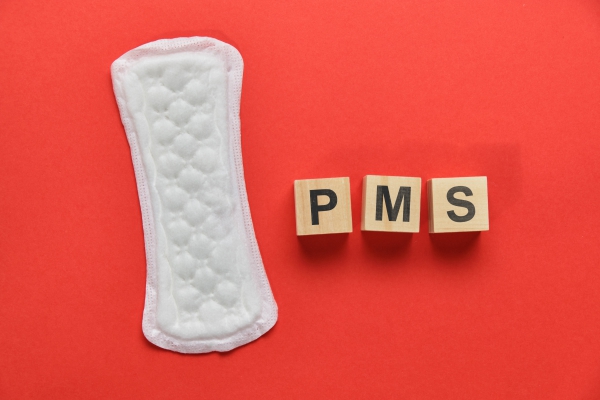What is Premenstrual syndrome?
Premenstrual syndrome (PMS) is a group of symptoms, be it physical, psychological and behavioural, that occurs recurrently and is closely related to changes in hormonal levels in the body, associated with a woman’s menstrual cycle. It can result in deterioration in interpersonal relationships and has an impact on a woman’s normal activities. Premenstrual dysphoric disorder (PMDD) is when PMS occurs in a severe form. It is considered as a mental disorder according to the American Psychiatric Association.
Mild PMS is a common condition present in more than 75% of women having regular menses, whereas PMDD is a condition that occurs in only 3 to 8% of women. Both arises in women of any ethnicity, cultural and socioeconomic background. Statistics show that older adolescents are more likely to have severe symptoms compared to younger ones. Furthermore, women in their forties tend to be affected most severely. Eventually, after menopause, since a woman no longer has her menstrual cycles, PMS completely resolves.
What are the causes of Premenstrual syndrome?
During the menstrual cycle, which normally lasts 28 days, levels of hormones fluctuate and varies depending on the phase you are in. These hormones include the following: estrogen and progesterone. Various tissues throughout your body are sensitive and respond according to changes of these hormonal levels.
Estrogen and progesterone also influence chemicals released in the brain (serotonin). This results in a change in mood. However, the exact cause of PMS or PMDD is not known. A hypothesis suggests that what may be differentiating woman with and without the condition is their levels of sensitivity to the hormonal changes. This means that some women may have an exaggerated response to hormone levels.

What are the risk factors of Premenstrual syndrome?
The following factors increases the risk of having PMS:
- Obesity especially those with a body mass index of 30 or above. This increases the risk by 3 folds.
- Smoking makes you twice more likely to have severe symptoms of PMS.
What are the symptoms of Premenstrual syndrome?
PMS and PMDD may present with the following symptoms:
- Weakness and fatigue
- Abdominal bloating
- Irritable mood
- Anxiety
- Depression including sadness, loss of hope and not feeling worthy
- Frequent tearfulness
- Feeling of anger for no reason
- Conflict with family members, co-workers or friends
- Decreased interest in usual activities
- Impaired concentration
- Decreased energy
- Binge eating or food cravings
- Increased or impaired sleeping
- Tender and swollen breasts
- Headaches
- Muscular pain
- Gain in weight
- Mood swings

How is the diagnosis of Premenstrual syndrome made?
To make the diagnosis, your doctor will first start by taking a thorough medical history from you. This will include your symptoms, the duration as well as the onset. Symptoms of PMS or PMDD usually arise during the second half of the menstrual cycle, that is 5-7 days prior to the start of menstrual period. Your doctor will enquire about the presence of both physical and behavioural symptoms. The symptoms should not be present at the beginning of the menstrual cycle (days 4-12; right after the cessation of your menstrual period till around ovulation time).

There are no specific test that can make the diagnosis of PMS or PMDD. Some tests may be requested to rule out other conditions that may mimic PMS or PMDD.

What is the treatment of Premenstrual syndrome?
There are several treatment options available to ease the symptoms present in PMS and PMDD. These include:
- Regular exercise: This can help to reduce stress, anxiety and depression in women.
- Relaxation techniques: Similarly, these techniques may help to reduce stress and anxiety as the latter can worsen PMS and PMDD. These techniques may include meditation, progressive muscle relaxation and self-hypnosis.
- Vitamin and mineral supplements: It has been shown that vitamin B6 may help in alleviating symptoms of mild PMS. However, not more than 100mg is recommended per day.
- Selective serotonin reuptake inhibitors (SSRIs): Studies have shown that this class of medication is effective for the treatment of PMS and PMDD. Some examples include the following: fluoxetine, sertraline, citalopram and paroxetine. Studies have shown that between 60-75% of women with PMDD had improved symptoms with SSRI. It is usually prescribed only during the second half of the menstrual cycle. However, some side effects may arise including a difficulty to have an orgasm.
- Birth control pills: These pills may provide relief in some cases of PMS or PMDD. In some other women, birth control pills may worsen PMS symptoms. In the United States, the birth control pill, Yaz, is the only approved treatment for PMDD.
- Gonadotropin-releasing hormone agonists: These medications work by stopping the production of estrogen and progesterone by your ovaries. This results in a temporary menopause and resolution of PMS symptoms. However side effects include: hot flashes and loss of bone with time.


What is the prognosis of Premenstrual syndrome?
The main concern with PMS is the inability to maintain normal activity levels. It may be the cause for school absences as well as behavioural problems. It has also been associated with eating disorders such as bulimia nervosa. PMS is also associated with an increased likelihood of having hypertension in the future.
Source:
Moreno, M., 2016. Premenstrual Syndrome
Yonkers, K., and Casper, R., 2020. Epidemiology and pathogenesis of premenstrual syndrome and premenstrual dysphoric disorder
Yonkers, K., and Casper, R., 2020. Clinical manifestations and diagnosis of premenstrual syndrome and premenstrual dysphoric disorder
Yonkers, K., and Casper, R., 2020. Treatment of premenstrual syndrome and premenstrual dysphoric disorder


